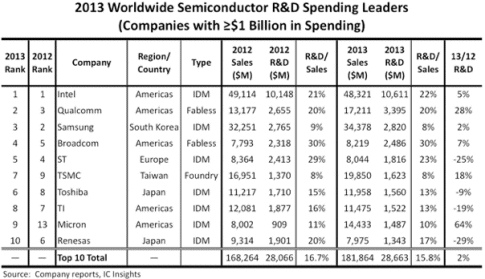Top 10 Semiconductor R&D Leaders Ranked for 2013
Intel is tops again, Micron and Qualcomm show biggest R&D increases, Broadcom with highest R&D/sales ratio
February 26, 2014 -- More than any other industry, the semiconductor business is defined by rapid technological change. As a result, a constant and high level of investment in R&D is essential to the competitive positions of semiconductor suppliers.
Figure 1 shows IC Insights’ 2013 ranking of semiconductor companies by R&D spending. Intel continued to top all other chip companies in R&D spending in 2013 and accounted for 37% of the top-10 spending and 19% of total worldwide semiconductor R&D expenditures! Intel’s R&D spending was more than 3x that of second-place Qualcomm, which displayed a very strong 28% increase in R&D spending in 2013 and solidified the company’s position as the second-largest R&D spender, a position it first achieved in 2012. Samsung was ranked third. It's annual R&D budget has remained relatively flat at $2.8 billion since 2011.
The industry’s two largest IDMs—Intel and Samsung—continue to emphasize internal production capacity for advanced ICs in leading-edge wafer fabs. However, spending on R&D programs at the two IC giants has been growing at different rates in recent years, partly due to Samsung’s ability to hold down some costs by participating in IBM’s Common Platform joint development alliance, which also includes GlobalFoundries as an R&D partner. The IBM alliance has helped Samsung to keep its R&D-to-sales ratio below 10% in recent years. Another explanation for Samsung’s low R&D-to-sales ratio is that its primary business is making and selling DRAM and flash memory devices, which are commodity-type products that are very capital-intensive, but not as R&D-intensive as the complex, high-performance logic-based products made by Intel and TSMC. Samsung’s sales have, in general, been growing much faster than its R&D spending (15% annual growth in sales during 2001-2013 versus 5% yearly growth for R&D spending over the same timeperiod).
Meanwhile, Intel—the industry’s trailblazer in many technologies—saw its R&D spending jump to 22% of its semiconductor sales in 2013 as compared to 21% in 2012 and 17% in 2011. The company’s R&D spending reached a record-high $10.6 billion in 2013, but it was just 5% above 2012 spending.

Figure 1
Number four-ranked Broadcom’s R&D spending as a percent of semiconductor sales was 30% in 2013. Broadcom, the second-largest fabless IC supplier, has had the highest R&D spending as a percentage of revenue among the top-10 spenders every single year since breaking into the top-10 ranks in 2006. Broadcom’s R&D-to-sales ratios varied widely during its formative years, including a couple years (2001 and 2002) when it spent all of its sales on R&D, but since 2006 the company’s R&D budgets have grown at the same 12% annual rate as its sales, keeping its R&D-to-sales ratios at an average of 31%!
Another interesting fact about the R&D spending ranking is that the top 10 companies spent almost one percentage point less on R&D as percent of semiconductor sales than the average for all chip companies in 2013 (15.8% versus 16.7%). That’s the first time the top-10 R&D/sales ratio came in at a lower rate than the overall industry ratio since IC Insights started reporting detailed semiconductor R&D trends in 2005. Combined R&D spending by the top 10 exceeded total spending by the rest of the semiconductor companies ($28.7 billion versus $26.0 billion) in 2013, something that has continued to hold true since 2005 and probably well before that.
Five of the top 10-ranked companies are based in the U.S., while two are in Japan, two in the Asia-Pacific region, and one in Europe. Two of the top 10—Qualcomm and Broadcom—are fabless semiconductor companies.
One result of the growing fabless and fab-lite trend is that, in 2010, for the first time ever, a pure-play foundry joined the group of top-10 semiconductor R&D spenders. TSMC, the industry’s largest foundry, increased its R&D spending a hefty 44% in 2010, moving it from 18th to 10th place in the R&D ranking in one year. The company’s R&D spending has continued to climb since then with 2013 R&D growing 18% to reach a little over $1.6 billion.
Report Details: The 2014 McClean Report
Further details on semiconductor R&D spending trends are provided in the 2014 edition of IC Insights’ flagship report, The McClean Report—A Complete Analysis and Forecast of the Integrated Circuit Industry. This highly regarded service features more than 900 pages and more than 400 tables and graphs that provide the user with a thorough analysis of IC industry trends throughout the year. A subscription to The McClean Report includes free monthly updates from March through November (including a 250+ page Mid-Year Update), and free access to subscriber-only webinars throughout the year. An individual-user license to the 2014 edition of The McClean Report is priced at $3,490 and includes an Internet access password. A multi-user worldwide corporate license is available for $6,490.
Related Semiconductor IP
- Ultra-Low-Power LPDDR3/LPDDR2/DDR3L Combo Subsystem
- 1G BASE-T Ethernet Verification IP
- Network-on-Chip (NoC)
- Microsecond Channel (MSC/MSC-Plus) Controller
- 12-bit, 400 MSPS SAR ADC - TSMC 12nm FFC
Related News
- Top Semiconductor R&D Leaders Ranked for 2014
- Top 10 Semiconductor R&D Spenders Increase Outlays 6% in 2017
- Cadence Announces Appointments of R&D and Worldwide Field Operations Leaders
- Arteris Ranked Number 144th Fastest Growing Company in North America on Deloitte's 2013 Technology Fast 500
Latest News
- Virtusa Acquires Bengaluru based SmartSoC Solutions, Establishing Full-Stack Service Offering from Chip to Cloud and Driving Expansion into the Semiconductor Industry
- Consumer Electronics and AI Product Launches Lift 3Q25 Top-10 Foundry Revenue by 8.1%, Says TrendForce
- Joachim Kunkel Joins Quadric Board of Directors
- RaiderChip NPU leads edge LLM benchmarks against GPUs and CPUs in academic research paper
- SEMIFIVE Secures AI Semiconductor Design Projects in Japan, Accelerating Global Expansion with New Local Subsidiary